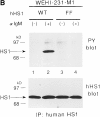Role of tyrosine phosphorylation of HS1 in B cell antigen receptor-mediated apoptosis
- PMID: 9104825
- PMCID: PMC2196252
- DOI: 10.1084/jem.185.7.1387
Role of tyrosine phosphorylation of HS1 in B cell antigen receptor-mediated apoptosis
Abstract
The 75-kD HS1 protein is highly tyrosine-phosphorylated during B cell antigen receptor (BCR)-mediated signaling. Owing to low expression of HS1, WEHI-231-derived M1 cells, unlike the parental cells, are insensitive to BCR-mediated apoptosis. Here, we show that BCR-associated tyrosine kinases Lyn and Syk synergistically phosphorylate HS1, and that Tyr-378 and Tyr-397 of HS1 are the critical residues for its BCR-induced phosphorylation. In addition, unlike wild-type HS1, a mutant HS1 carrying the mutations Phe-378 and Phe-397 was unable to render M1 cells sensitive to apoptosis. Wild-type HS1, but not the mutant, localized to the nucleus under the synergy of Lyn and Syk. Thus, tyrosine phosphorylation of HS1 is required for BCR-induced apoptosis and nuclear translocation of HS1 may be a prerequisite for B cell apoptosis.
Figures








Similar articles
-
Syk-mediated tyrosine phosphorylation is required for the association of hematopoietic lineage cell-specific protein 1 with lipid rafts and B cell antigen receptor signalosome complex.J Biol Chem. 2004 Aug 6;279(32):33413-20. doi: 10.1074/jbc.M313564200. Epub 2004 May 27. J Biol Chem. 2004. PMID: 15166239
-
CD19 amplifies B lymphocyte signal transduction by regulating Src-family protein tyrosine kinase activation.J Immunol. 1999 Jun 15;162(12):7088-94. J Immunol. 1999. PMID: 10358152
-
Thrombin-induced tyrosine phosphorylation of HS1 in human platelets is sequentially catalyzed by Syk and Lyn tyrosine kinases and associated with the cellular migration of the protein.J Biol Chem. 2005 Jun 3;280(22):21029-35. doi: 10.1074/jbc.M412634200. Epub 2005 Mar 28. J Biol Chem. 2005. PMID: 15795233
-
Lyn tyrosine kinase: accentuating the positive and the negative.Immunity. 2005 Jan;22(1):9-18. doi: 10.1016/j.immuni.2004.12.004. Immunity. 2005. PMID: 15664155 Review.
-
The tyrosine activation motif as a target of protein tyrosine kinases and SH2 domains.Semin Immunol. 1995 Feb;7(1):21-7. doi: 10.1016/1044-5323(95)90004-7. Semin Immunol. 1995. PMID: 7612891 Review.
Cited by
-
The Phox homology (PX) domain, a new player in phosphoinositide signalling.Biochem J. 2001 Dec 15;360(Pt 3):513-30. doi: 10.1042/0264-6021:3600513. Biochem J. 2001. PMID: 11736640 Free PMC article. Review.
-
Characterization of Pipefish Immune Cell Populations Through Single-Cell Transcriptomics.Front Immunol. 2022 Jan 27;13:820152. doi: 10.3389/fimmu.2022.820152. eCollection 2022. Front Immunol. 2022. PMID: 35154138 Free PMC article.
-
Cortactin, another player in the Lyn signaling pathway, is over-expressed and alternatively spliced in leukemic cells from patients with B-cell chronic lymphocytic leukemia.Haematologica. 2014 Jun;99(6):1069-77. doi: 10.3324/haematol.2013.090183. Epub 2014 Feb 14. Haematologica. 2014. PMID: 24532043 Free PMC article.
-
Haematopoietic lineage cell-specific protein 1 (HS1) promotes actin-related protein (Arp) 2/3 complex-mediated actin polymerization.Biochem J. 2003 Apr 15;371(Pt 2):485-93. doi: 10.1042/BJ20021791. Biochem J. 2003. PMID: 12534372 Free PMC article.
-
Phospholipase C-gamma2 and Vav cooperate within signaling microclusters to propagate B cell spreading in response to membrane-bound antigen.J Exp Med. 2008 Apr 14;205(4):853-68. doi: 10.1084/jem.20072619. Epub 2008 Mar 24. J Exp Med. 2008. PMID: 18362175 Free PMC article.
References
-
- Yamanashi Y, Kakiuchi T, Mizuguchi J, Yamamoto T, Toyoshima K. Association of B cell antigen receptor with protein tyrosine kinase Lyn. Science (Wash DC) 1991;251:192–194. - PubMed
-
- Bolen JB. Protein tyrosine kinases in the initiation of antigen receptor signaling. Curr Opin Immunol. 1995;7:306–311. - PubMed
-
- Hibbs ML, Tarlinton DM, Armes J, Grail D, Hodgson G, Maglitto R, Stacker SA, Dunn AR. Multiple defects in the immune system of Lyn-deficient mice, culminating in autoimmune disease. Cell. 1995;83:301–311. - PubMed
-
- Nishizumi H, Taniuchi I, Yamanashi Y, Kitamura D, Ilic D, Mori S, Watanabe T, Yamamoto T. Impaired proliferation of peripheral B cells and indication of autoimmune disease in lyn-deficient mice. Immunity. 1995;3:549–560. - PubMed
Publication types
MeSH terms
Substances
LinkOut - more resources
Full Text Sources
Other Literature Sources
Molecular Biology Databases
Research Materials
Miscellaneous

